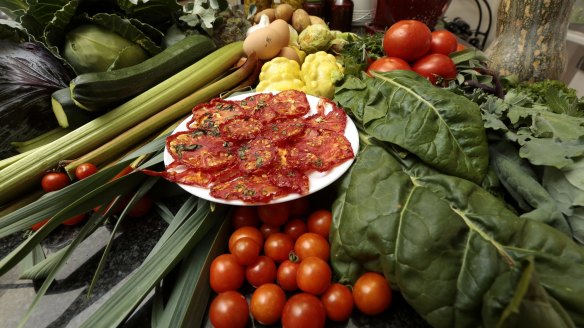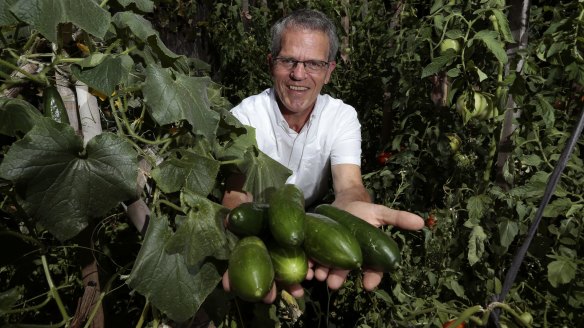Scientist Maarten Stapper takes us inside his Canberra garden
Former CSIRO expert Maarten Stapper gets his hands dirty with top-notch soil at his Holder townhouse.

We last met agricultural scientist Dr Maarten Stapper when he was working with grains at the CSIRO (Kitchen Garden, August 31, 2004). Since then, he has featured on the ABC's Australian Story (2009), about his road into biological farming systems and withdrawal from the official world of science.
He wants to help farmers harness the power of natural soil processes to regenerate and create healthy soils, to improve the quality of food, animal feed and landscapes, and make them more resilient in a variable climate.
Over spring, he spoke to hundreds of farmers and communities in Western Australia, between Boyup Brook and Geraldton, and at community gardens in Perth. Caring for our Country has funded part of his environmental advocacy.

Five years ago, he moved into a townhouse in Holder where he and his wife Margaret garden organically, following permaculture principles, in their extensive home garden. They have two tanks, one 4000 litres and the other 8000 litres, one draining into the other. A pump directs water to four major garden beds, with drippers. Effectively, no rain leaves the property.
Beside a four-year-old mulberry tree, which produced 135 kilograms of fruit over summer, they have a Totterdell trench, named after the Canberra inventor and water harvester Paul Totterdell.
It is 70 centimetres deep, lined with cloth to stop roots invading, and is filled with gravel and sand. An ag pipe leads water from the tank into the trench, which is topped with 50 centimetres of topsoil.
The main courtyard leads off the living room, and a grapevine shades an outdoor table surrounded by carefully netted fig and plum trees. The enclosed chook run is enhanced by a large magnolia tree. Their Isa Brown hens are two years old and produced 1000 eggs in 11 months. They are fed weeds from the garden, and dandelions and milk thistle Maarten weeds from public land in Holder.
A raised bed is filled with tomato plants, and the couple made a cucumber tent from fallen eucalypt branches from a eucalypt growing nearby. This enables the cucumbers to hang down from the branches of the tied-up plants. Self-sown curly parsley and rocket grow throughout the beds and there is no soil to be seen, because a litter layer of mulch from decomposing old growth or weeds covers the dirt.
Maarten says abundant and diverse soil biology, from microbes to earthworms, regenerates soils, making new soil through humus production; more carbon going in than out of the soil. No tilling is required and no synthetic fertilisers or chemicals are used.
A gate leads to a side garden where raspberries, boysenberries, loganberries and thornless blackberries grow among rhubarb plants, and purple beans climb a wall frame.
There are sunchokes, also known as Jerusalem artichokes, corn, celery and kale. A worm farm provides "worm wee" which is diluted and watered onto plants. Maarten says the skin of fruits and vegetables is harder if they are grown organically, with full availability of minerals, which deters insects and gives the produce a longer shelf life.
For three hours on Saturday mornings, the pair garden together in the Canberra Organic Garden Society community garden, also in Holder. Maarten is the garden's treasurer. They have had an 80-square-metre plot for two years, where they grow Dutch cream and Desiree potatoes, pumpkins, red and green cabbages, Brussels sprouts and broccoli.
Margaret's father lived in the Hunter Valley and, eight years after he died, the Stappers raised from seed a meaty heirloom Pink Queen tomato he grew. They thinly slice the tomatoes and dry them with basil in a dehydrator. They were once served them this way at Sage restaurant in Braddon as a delicious snack, and loved the idea.
Both Margaret and Maarten enjoy cooking. She works as a teacher, and cooks on the weekends, while he cooks from Monday to Friday.
Maarten grew up in a home-cooking culture. He was raised in Ouderkerk aan de Amstel, in the middle of dairy country in North Holland. On the weekends, although he had sisters, Maarten helped his mother cutting fruit for jams, making sauce for cauliflower, peeling potatoes for soup day on Saturdays, and making meatballs with herbs and spices for Sundays.
He recalls they also ate boerenkool, a one-pot meal of farmers' cabbage, which the family would eat with mashed potatoes and sausage after ice skating.
One of his favourite books is The Preserving Book (2010) written by Lynda Brown with the UK Soil Association. In autumn, he makes Indian chutney with 2.5 kilograms of pumpkin and zucchini, and a Mediterranean chutney from eggplant, zucchini, onion and herbs.
Once at a Bredbo restaurant, he tried pickled green tomatoes and now uses a recipe from Preserving (1996), by Oded Schwartz, for 20 kilograms of green tomatoes with garlic, dill, onions and mustard seeds. Last week, he made Schwartz's spiced cherry tomatoes, with vinegar sweetened with home-grown stevia.
Any friends who provide clean used jars are given a home-made jar of bread and butter pickles made to a recipe from Stephanie Alexander's The Cook's Companion (2004). Maarten uses 2.5 kilograms of cucumbers, or small pickling cucumbers, or zucchini; with onion, dill, salt, sugar, mustard seed, turmeric, chilli flakes and white wine vinegar.